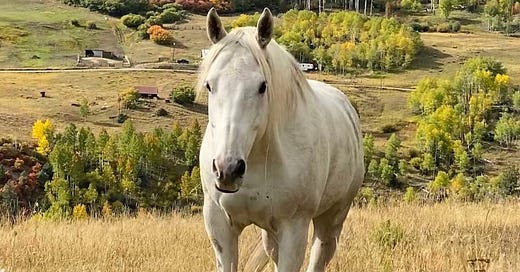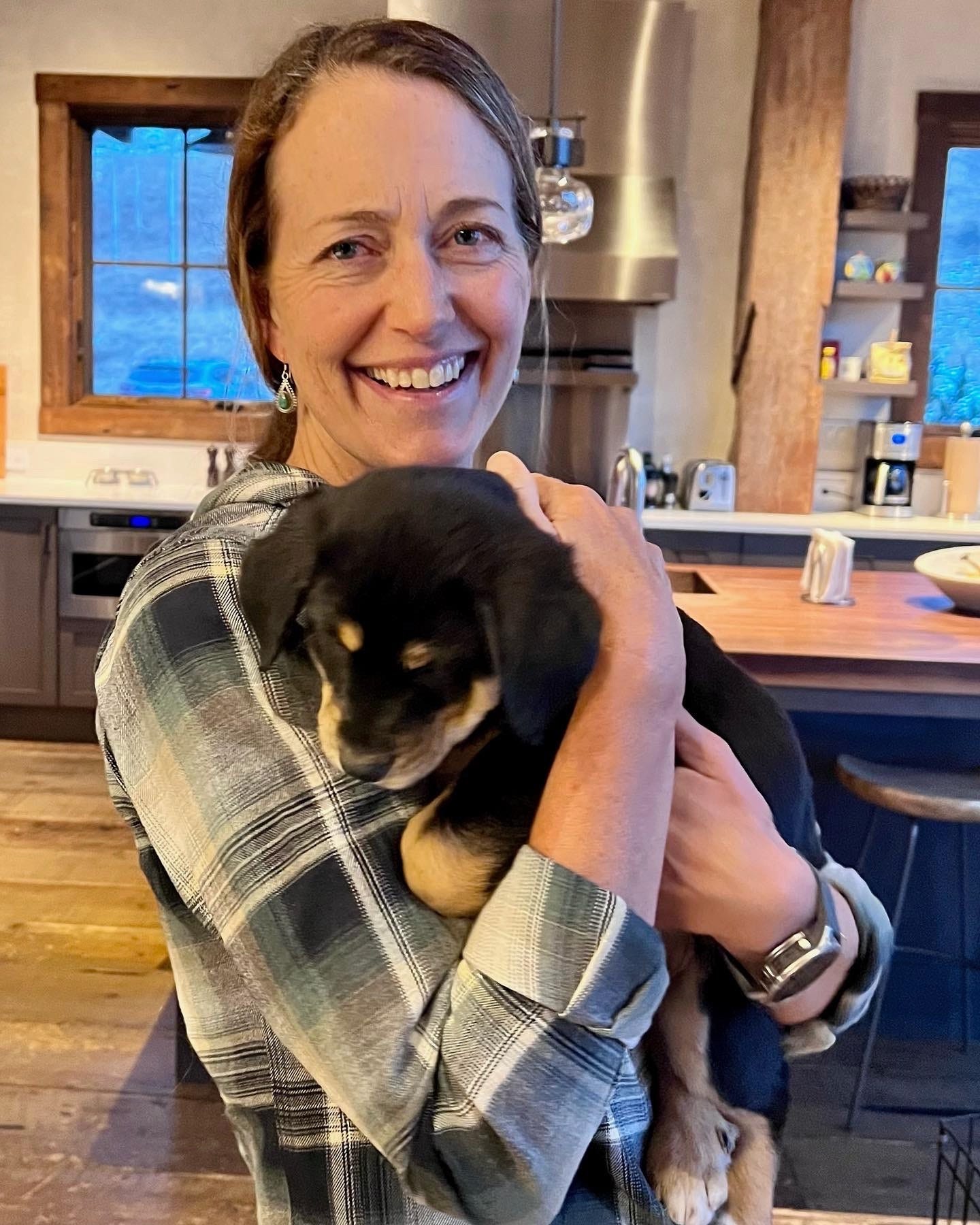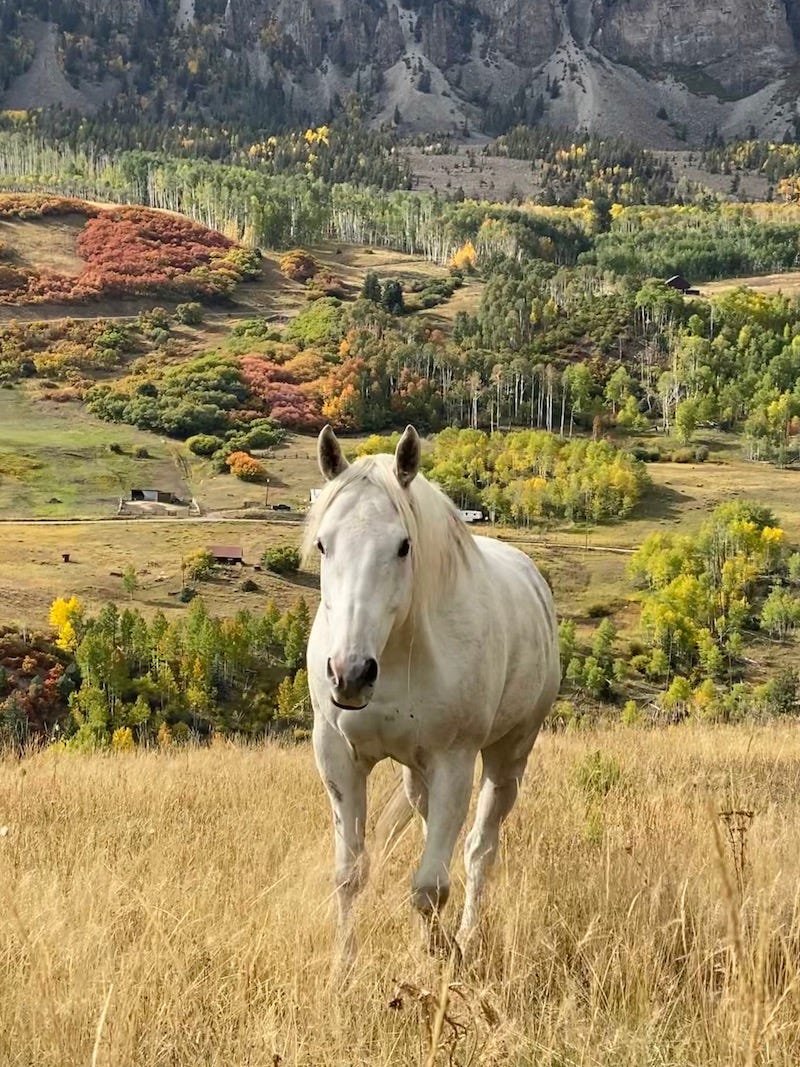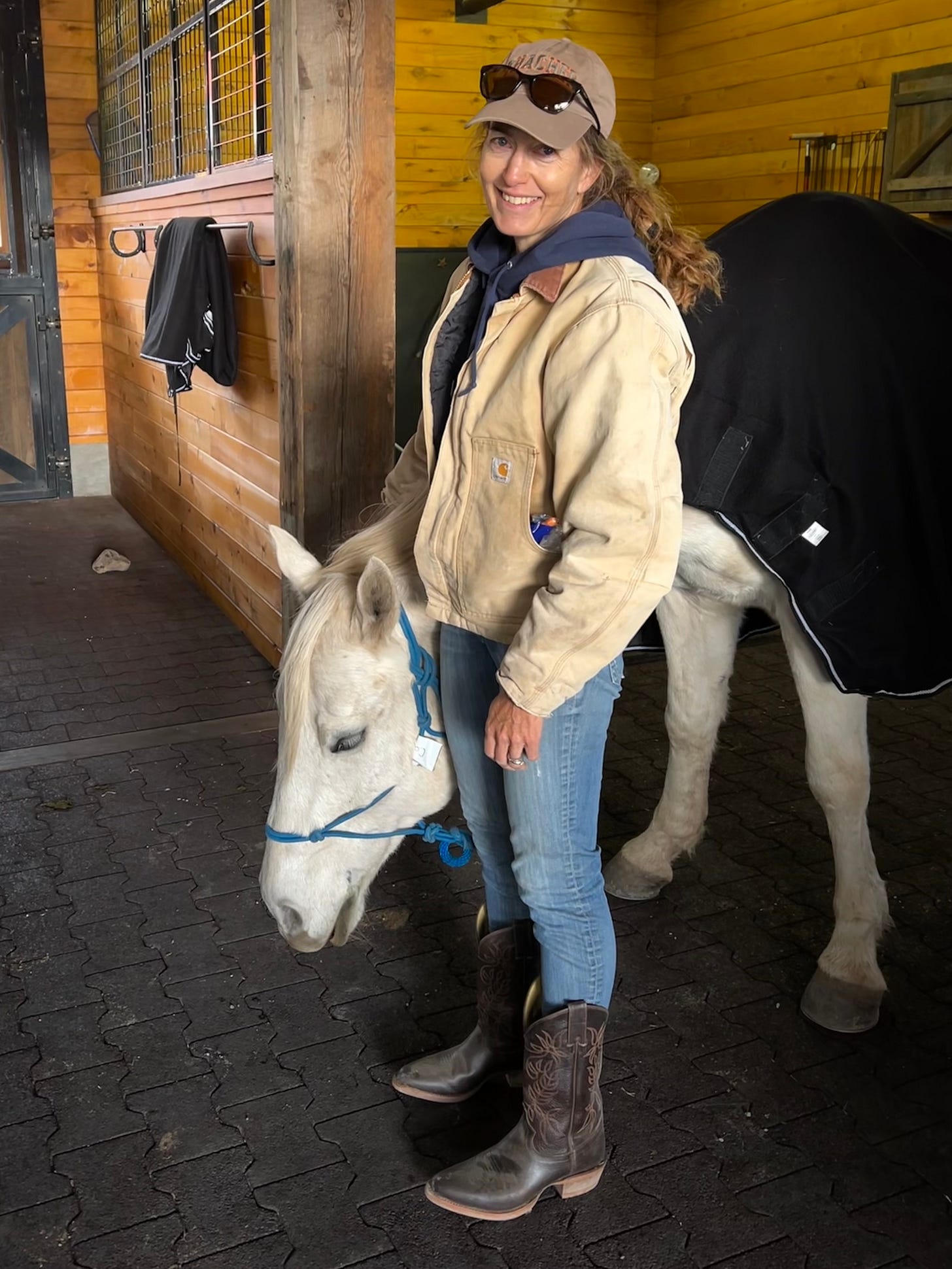Today’s post comes late in the day because I’m on puppy time.
We adopted a 9-week-old shepherd mix from a shelter on Monday and named her Daisy, so for the past 48 hours I’ve mostly sat on the floor as if all that matters is this little creature and her chew toys. (Email definitely can’t compete with puppy care.) Then I bundle up at least once an hour to go outside for house training.
When not focused on Daisy, I’m lavishing attention on our 2-year-old dog, Dakota, who is suspicious but slowly warming up to this thing that wants to chase her (unlike the cat, who lurks on the periphery and hisses in the puppy’s direction). I slept very little on Daisy’s first night home while she cried in her crate because she missed her siblings. All in all, however, she’s adapting beautifully, and I’m smitten. She came into our life as unexpectedly as our older dog left it two weeks ago. This has been an animal-intensive emotional week, the subject of this post.
I had a big cry Saturday night, the kind of heaving crying that comes maybe once a year and only my husband gets to witness. I’ll describe it not because I want sympathy, and not because I want to write a downer post. Rather, I’d like to process what triggered it and share what I’m doing to cope with feeling discouraged, at times borderline hopeless.
Nothing that bad has happened. I’m fine, my family is fine. I still live in the dream house we put everything into building and daily look out at Wilson Peak, and there’s nowhere I’d rather live. My kids are healthy and seem to be adulting well. My life partner who’s my rock is still at my side, and listening to his breathing in the middle of the night calms me and helps me get back to sleep.
And no, I did not cry over the Hardrock 100. I did not get an entry spot in last Saturday’s lottery, even though I have been trying since 2015 and had 64 tickets in the pool. My chances were still only 29%. Friends with more tickets also didn’t get drawn. I’m resigned to the odds that I may never get a spot in this race, which is my main running goal, or it may take so many years that my knee gives out before then.
I cried over our horse Cobalt, and all the feelings of vulnerability and lack of control triggered by his strange, surprising lameness—one of many unforeseen and unfortunate events this year. I had a meltdown because I’m gripped by exaggerated fear that other people and things I love will be damaged by age and change, and because Cobalt’s condition mirrors my own midlife decline as an athlete.
I went to ride Cobalt and our other horse Maverick on Saturday as a pick-me-up and because I miss feeding and exercising them daily. They’re 45 minutes away in Norwood for the winter, hanging out in a pasture at a stable that has a top-notch indoor arena where we can ride regardless of outdoor conditions. Our high-elevation home gets too snowy and icy to manage their exercise and care during winter.
As my husband and I drove there, and I processed the disappointment of not getting chosen for Hardrock, I pondered how and why horsemanship brings pure, simple joy more than running. I think it has to do with my relationship to running being heavy with the baggage of self-imposed performance expectation. Also, ultrarunning is an endurance sport, by nature difficult. Its highs and lows—emotional, physical, topographical—feel dramatic and depleting, and sometimes the experience feels more fun in hindsight, upon finishing, than in any moment on a trail.
Riding, by contrast, always feels relatively easy, calming, and restorative. It’s one of the few things in life I feel naturally good and confident doing, the way some people feel about dancing or playing an instrument by ear.
Riding became “my thing” in childhood and then therapy in adolescence, though I didn’t fully appreciate its role at the time. I’m privileged to have horses because it’s part of my family’s culture, heritage, maybe even DNA. I ride for the sensations, the setting, and the relationship with the horse, not for competition. Maverick and Cobalt give back to me through their body language and movement, and they activate my senses, especially smell. We perk up when we see each other, and nothing complicates our relationship.
While both horses move and behave exceptionally well, Cobalt’s smooth canter carries me to a higher level of elation as a rider. Always taking the lead ahead of Maverick, Cobalt is the equine equivalent of the runner we all want to be. (The Instagram post below has a clip of him cantering.)
He strides out with determination and momentum that releases a seemingly bottomless supply of bottled-up energy. You can tell by his willingness to canter and his forward momentum that he wants to run. To ride his canter and then ask him to go even faster at a gallop—and to feel him eagerly respond, as if he were waiting to be asked—is to feel that dream-state sensation of flying as if swimming through air, supported underneath so you won’t fall from the sky. I feel entirely secure while cantering Cobalt, in control and in partnership with him, because our bodies are fully in synch as I communicate subtle cues through my back, legs, and hands.
One month ago on November 6, however, Cobalt suddenly developed a hitch in his stride. For no apparent reason—unless, perhaps, he slipped and pulled something while turned loose and running around our arena—he felt reluctant to canter. He was OK at the walk and trot, but his hind end seized up at the higher gait. He started giving little bucks with his back legs, which he had never done before. He was sweating more than normal, wrinkling his nostrils, and putting his ears back—all signs that he felt stressed and uncomfortable.
I felt rattled and concerned but figured rest was the best first course of treatment. We let him rest for three weeks with minimal riding at the walk and jog, and then when he still seemed not quite normal, we had the equine vet visit November 28 for diagnosis and treatment.
She examined him and took Xrays that revealed something similar to what a recent MRI on my knee revealed: the loss of cartilage in his hocks, which are the rear-pointing joints midway down a horse’s back legs, evolutionarily equivalent to our ankles. She reassured us that this is normal for a middle-aged horse (Cobalt is 12), and that draining the swelling and giving his hocks a steroid injection will get him moving normally again. She inserted needles that caused excess fluid to flow down his lower hind legs, and then she gave him a shot. In five or so days, she reassured me, he likely would be his old self.
Saturday, I drove to the barn mustering all my optimism that Cobalt would in fact be back to normal. We groomed, tacked up, and slowly warmed up in the arena. I balanced on his back with a loose rein and light legs, asking little of him except that he move naturally so I could feel how he feels. His walk and trot seemed agreeable. But when asked for the canter, Cobalt again resisted engaging his hind end. His stride felt choppy and hesitant, not flowing. When I asked him to canter in a circle to the right, he protested by swishing his tail and keeping his backs legs closer together than they should be. Then, he pushed off the ground with both back legs together to rise up with a little buck. I knew this wasn’t misbehavior, it was his way of expressing pain.
I fought back tears as I stroked his neck at the walk and tried to reassure him. I can handle a lot of disappointment, but the idea that Cobalt was feeling pain and starting to fall apart in middle age, so soon after our dog died from sudden illness, sent me over an emotional edge. Five weeks ago, he seemed 100 percent fine. I didn’t see this coming.
Not only had his hocks been inflamed, he apparently has soreness or misalignment higher up. The vet says we’ll have to work on his stifle (the equine equivalent of the knee) and his SI joint in the pelvis.
I can relate, and thus I project my feelings on him. Beyond my bum knee that’s headed toward osteoarthritis, I have high hamstring tendinopathy and a misaligned pelvis that causes lower back pain. I don’t want to have to manage my knee or Cobalt’s stifle with injections of hyaluronic acid (which acts as a joint lube) or hydrocortisone (which reduces pain from inflammation), yet we both want to run. Whereas I would run through pain, however, I am fiercely and maternally protective of Cobalt and would not do anything to hurt him. It just breaks my heart that his movement may be restricted.
That night, everything disappointing about the year collided like a car wreck in my mind. While I won’t go into details, we have become wrapped up in not one but two expensive lawsuits. One stems from someone who cheated us financially, the other involves a threat to the landscape and a breach of contract. Both blindsided us this spring and made me feel powerless and chronically stressed. Then in early summer, I had to say goodbye to my mom (which was peaceful and not unexpected, but made me grieve her and my dad and feel mortality acutely).
All along, I have felt despair about the news, from Ukraine to climate change to the prospect of our presidential choice being Trump v. Biden again. The negative feelings came to a head around Thanksgiving (story here) as our anticipated special trip to Peru fell apart and sweet Beso declined and died in our absence, so much faster than we could fathom.
So even though Cobalt will probably be fine, or close to fine, longer term, and he isn’t suffering now, I overreacted to the (temporary?) loss of his smooth canter as if another person had died. I felt vulnerable and prone to bad luck, telling my husband I didn’t want him to leave me for travel next week. Fear, pessimism, and aging took over the intrepid, optimistic, youthful person I strive to be. I cried harder than I had even when my mom and dog died.
I passed out in a deep sleep and made myself take action on Sunday in ways that nurture optimism and restore some feeling of control over the circumstances, even though I didn’t feel it. It’s the old “fake it ‘til you make it” hack.
I met a friend for a longer run in the morning.
I went to the library that afternoon to see a bilingual film, to connect with others and practice Spanish. (The film Outliers, about Latinas ski mountaineering, with broader themes about identity and belonging, is excellent—see it if you can.)
I registered for September’s Run Rabbit Run 100.
I decorated our Christmas tree.
I decided fuck it, I don’t have to prepare and mail a Christmas card, which feels forced and like a chore. I can take a year off from that tradition; I’ll write a personal email to the old friends I genuinely care about keeping in touch with instead.
I planned a winter solstice bonfire party.
I signed up for substitute teaching shifts.
We decided to reschedule our big trip for spring (if the trip insurance money comes through).
I said “yes” when the pastor at the progressive Presbyterian church emailed to ask me to do the Advent candle lighting next Sunday, even though I’m basically agnostic and think organized and orthodox religion causes much of the world’s oppression and conflict—still, I feel drawn to the Advent themes, to Christ as a role model, and to being in community with others.
Best by far, we dropped everything to drive two hours to Durango to adopt this puppy when she became available. It felt like rolling the dice, and I was due for good luck. The Denkai Animal Sanctuary rescued her pregnant mother from a reservation in New Mexico, and all seven mutt pups needed a home. How could we not?
Today, I could gush with gratitude for all the blessed things in life. I feel more hopeful and happy on puppy time.
What everyday actions do you take to help cope with setbacks or pessimism? You can comment below or join the online chat on the Substack app, which now is available for Android too.
And please check out last week’s gift guide with some ideas for more meaningful, less materialistic gifts in case you missed it.










This is so relatable.. When things come to a head and you've been sucking it up for God knows how long. Thank you for sharing something vulnerable and humanistic. Release, relinquish, and move forward. I feel you on this!
Thank you for being real and brave enough to share Sarah!